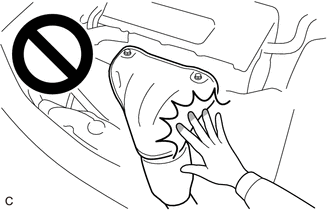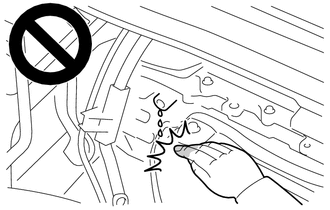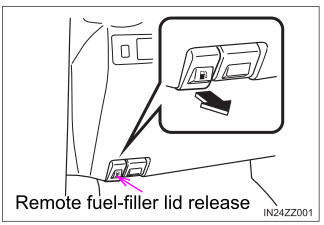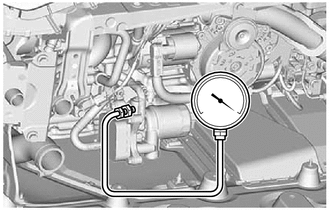Toyota Yaris: Oil Pressure And Temperature Sensor / On-vehicle Inspection
ON-VEHICLE INSPECTION
CAUTION / NOTICE / HINT
CAUTION:
-
To prevent burns, do not touch the engine, exhaust manifold or other high temperature components while the engine is hot.

-
To prevent burns, do not remove the oil pressure and temperature sensor while the engine is hot.

PROCEDURE
1. INSPECT OIL PRESSURE AND TEMPERATURE SENSOR
(a) Disconnect the oil pressure and temperature sensor connector.
HINT:
By disconnecting the oil pressure and temperature sensor connector, the non-regulated oil pressure can be measured.
(b) Read the value displayed on the GTS.
(1) Connect the GTS to the DLC3.
(2) Start the engine.
(3) Turn the GTS on.
(4) Enter the following menus: Powertrain / Engine / Data List / Engine Speed, Engine Oil Temperature Sensor and Engine Oil Pressure.
Powertrain > Engine > Data List| Tester Display |
|---|
| Engine Speed |
| Engine Oil Temperature Sensor |
| Engine Oil Pressure |
(5) With the engine oil temperature at 75 to 85°C (167 to 185°F), read the "Engine Oil Pressure" with the engine speed at 2000 rpm.
(c) Read the oil pressure using an oil pressure gauge with adapter.
(1) Remove the oil pressure and temperature sensor.
Click here

CAUTION:
Make sure the engine is cold when removing the oil pressure and temperature sensor to prevent burns caused by hot engine oil.
| (2) Install the oil pressure gauge with adapter. NOTICE: Clean the hose and adapter of the oil pressure gauge before and after measurement. |
|
(3) Start the engine.
(4) Enter the following menus: Powertrain / Engine / Data List / Engine Speed and Coolant Temperature.
Powertrain > Engine > Data List| Tester Display |
|---|
| Engine Speed |
| Coolant Temperature |
HINT:
When the engine oil pressure and temperature sensor is removed, the engine oil temperature cannot be checked, so refer to "Coolant Temperature".
(5) Maintain "Coolant Temperature" at 90 to 95°C (194 to 203°F) for 3 minutes, and then read the oil pressure gauge value at 2000 rpm.
HINT:
- Race the engine as necessary to maintain "Coolant Temperature" at 90 to 95°C (194 to 203°F).
- If maintained for 3 minutes or more, the engine oil temperature may exceed 85°C (185°F).
(d) Compare the Data List value and the oil pressure gauge reading.
OK:
Data List value and gauge reading are within +/-50 kPa (7.3 psi) of each other
(1) Remove the oil pressure gauge with the adapter.
CAUTION:
Removing the oil pressure gauge with adapter while the engine is hot could result in burns caused by contact with hot engine oil.
(2) Install the oil pressure and temperature sensor.
Click here

(e) Connect the oil pressure and temperature sensor connector.
HINT:
Be sure to clear the DTCs after reinstalling the oil pressure and temperature sensor or reconnecting the oil pressure and temperature sensor or oil pressure control valve assembly connector, as DTCs may be stored.
 Components
Components
COMPONENTS ILLUSTRATION
*1 OIL PRESSURE AND TEMPERATURE SENSOR *2 NO. 1 ENGINE UNDER COVER ASSEMBLY
Tightening torque for "Major areas involving basic vehicle performance such as moving/turning/stopping" : N*m (kgf*cm, ft...
 Removal
Removal
REMOVAL PROCEDURE 1. REMOVE NO. 1 ENGINE UNDER COVER ASSEMBLY Click here
2. REMOVE OIL PRESSURE AND TEMPERATURE SENSOR (a) Disconnect the oil pressure and temperature sensor connector...
Other information:
Toyota Yaris XP210 (2020-2025) Reapir and Service Manual: ABS Pump Motor Control Circuit Voltage Out of Range (C052C1C)
DESCRIPTION DTC No. Detection Item DTC Detection Condition Trouble Area DTC Output from C052C1C ABS Pump Motor Control Circuit Voltage Out of Range Any of the following is detected: When the +BS terminal voltage is from 9.5 to 17...
Toyota Yaris XP210 (2020-2025) Reapir and Service Manual: 4wd Control Switch
ComponentsCOMPONENTS ILLUSTRATION *1 CONSOLE BOX ASSEMBLY *2 4WD CONTROL SWITCH (NO. 2 COMBINATION SWITCH ASSEMBLY) RemovalREMOVAL PROCEDURE 1. REMOVE CONSOLE BOX ASSEMBLY Click here 2. REMOVE 4WD CONTROL SWITCH (NO. 2 COMBINATION SWITCH ASSEMBLY) (a) Remove the 3 screws and 4WD control switch (No...
Categories
- Manuals Home
- Toyota Yaris Owners Manual
- Toyota Yaris Service Manual
- Engine Start Function When Key Battery is Dead
- Diagnostic Trouble Code Chart
- Power Integration No.1 System Missing Message (B235287,B235587,B235787-B235987)
- New on site
- Most important about car
Refueling
Before refueling, close all the doors, windows, and the liftgate/trunk lid, and switch the ignition OFF.
To open the fuel-filler lid, pull the remote fuel-filler lid release.


